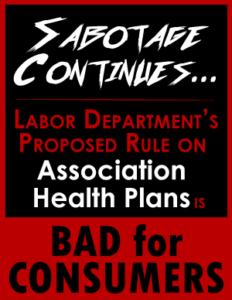 In an Oct. 12 Executive Order, the Trump White House ordered its Secretary of Labor to consider allowing more employers to form association health plans. In compliance with that order, the Department of Labor on Jan. 5 issued a new proposed rule aimed at encouraging the formation of more association health plans or AHPs.
In an Oct. 12 Executive Order, the Trump White House ordered its Secretary of Labor to consider allowing more employers to form association health plans. In compliance with that order, the Department of Labor on Jan. 5 issued a new proposed rule aimed at encouraging the formation of more association health plans or AHPs.
Increasing the prevalence of AHPs, however, could cause health care costs to spiral out of control, while reducing consumer protections for those enrolled in the plans. Ultimately, expanding the number of AHPs could decrease the number of quality health plans available to consumers while destabilizing the marketplace over all, making all consumers worse off.
The Affordable Care Act (ACA) already provides several options that allow small employers and their employees to purchase comprehensive health coverage at an affordable cost. This proposed regulation is unnecessary, and will do more harm than good — especially to those with preexisting health conditions.
What are Association Health Plans or AHPs?
AHPs are plans sold to small employers or individuals who have voluntarily affiliated into trade and professional associations to purchase coverage together as a group. Association health plans exist in law today as state-regulated multiple-employer welfare arrangements that are connected to a trade association or professional group, like a Bar Association or Chamber of Commerce.
Multiple-employer welfare arrangements are arrangements in which multiple employers—often small businesses—come together to buy health coverage as a group. Joining allows these arrangements to harness greater purchasing power and spread risk across more people. They proliferated during the 1970s and 1980s, and were largely unregulated during that time by states or the federal government. During the 1980s, several large multiple-employer welfare arrangements became insolvent—or even committed fraud—leaving consumers without the health care services they needed and providers unpaid for services they had already provided.
What would the proposed regulation do?
The proposed rule would change the definition of an employer under the Employee Retirement Income Security Act (ERISA) — only for the purposes of buying health insurance — to allow groups of small employers to form associations to purchase health insurance together and use their combined numbers to qualify as a large group for the purpose of various insurance rules. When these association health plans operate as large group plans, they would be exempt from many consumer protections, like the requirement that plans provide a comprehensive scope of benefits, and limits on how much a plan can charge older people compared to younger people. As a result, association health plans are likely to charge higher premiums and more cost sharing for less coverage. Most alarmingly, allowing more association health plans into the marketplace could lead to a return of fraud and abuse by plans, since they will generally be less regulated than most other health plans.
The ACA has created affordable alternatives to association health plans. States may expand Medicaid to help the lowest-income workers to obtain affordable coverage. Individual employees may purchase coverage through insurance exchanges, often with the assistance of sizable tax subsidies. Small employers may participate in the Small Business Health Options Program (SHOP) Marketplace to offer their employees comprehensive coverage.
As the Labor Department notes in the preamble to the proposed rule, Congress has declined to expand association health plans several times. There is no reason to do so now through an agency regulation.
Comments on the rule are due on or before March 6, 2018. NHeLP urges stakeholders to read the proposal and submit comments opposing the new rules here.
